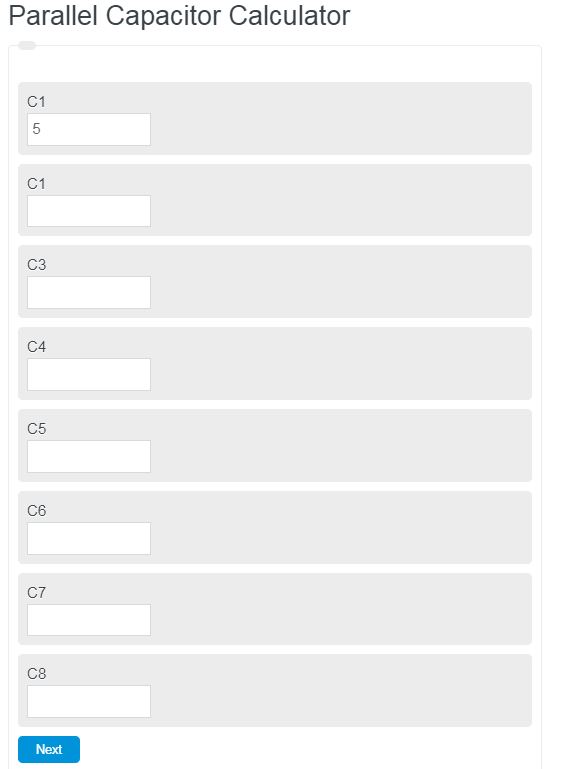Enter the capacitance of up to 8 capacitors in parallel into the calculator below to calculate the resulting capacitance. Capacitors, in parallel, increase the overall capacitance.
- Capacitor Series Calculator
- Capacitance Calculator
- Capacitor Energy Storage Calculator
- Capacitor Discharge Calculator
Parallel Capacitor Formula
The following equation can be used to calculate the total resulting capacitance of a set of capacitors in a parallel configuration.
C = C1 + C2 + C3....
- Where C is the total capacitance
- and C1 – CX is the individual capacitance of each capacitor
As seen in the formula above, capacitors in parallel yield a significantly larger capacitance than ones in a series. This is because in parallel, each capacitor sees the same voltage, while in a series, that voltage is split. Since capacitance is calculated through charge and voltage, the capacitance, therefore, depends on the volts running through each capacitor. The units for the equation above are in Farads, the standard unit for capacitance.
Parallel Capacitor Definition
A parallel capacitor is a type of electrical component that plays a crucial role in various electronic circuits. It consists of two conductive plates separated by a dielectric material. Unlike a series capacitor, which is connected in line with the circuit, a parallel capacitor is connected in parallel, meaning it shares the same nodes as other components.
The primary purpose of a parallel capacitor is to store and release electrical energy. When a voltage is applied across its terminals, the capacitor charges up by accumulating electrons on one plate and removing them from the other.
This results in creating an electric field between the plates, which stores the energy. Once charged, the parallel capacitor can discharge this energy back into the circuit when required.
One key advantage of using parallel capacitors is their ability to stabilize voltage levels. They act as reservoirs of electrical energy, providing a source of power during sudden voltage drops or spikes. By absorbing excess voltage or releasing stored energy to compensate for voltage drops, parallel capacitors help to maintain a stable voltage across the circuit.
This stability is crucial for ensuring the proper functioning and protection of sensitive electronic devices.
How to calculate parallel capacitance?
how to calculate capacitance in parallel
- First, measure the capacitance of each of the capacitors.
Measure the capacitance individually.
- Next, calculate the equivalent capacitance.
Sum all of the individual capacitances to get the equivalent capacitance.
FAQ
Parallel capacitors are a combination of two or more capacitors whose voltage can split through each capacitor equally.
